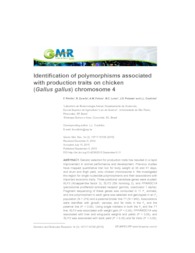Identification of polymorphisms associated with production traits on chicken (Gallus gallus) chromosome 4.
Identification of polymorphisms associated with production traits on chicken (Gallus gallus) chromosome 4.
Author(s): PÉRTILLE, F.; ZANELLA, R.; FELÍCIO, A. M.; LEDUR, M. C.; PEIXOTO, J. de O.; COUTINHO, L. L.
Summary: Genetic selection for production traits has resulted in a rapid improvement in animal performance and development. Previous studies have mapped quantitative trait loci for body weight at 35 and 41 days, and drum and thigh yield, onto chicken chromosome 4. We investigated this region for single nucleotide polymorphisms and their associations with important economic traits. Three positional candidate genes were studied: KLF3 (Krüeppel-like factor 3), SLIT2 (Slit homolog 2), and PPARGC1A (peroxisome proliferator-activated receptor gamma, coactivator 1 alpha). Fragment sequencing of these genes was conducted in 11 F1 animals, and one polymorphism in each gene was selected and genotyped in an F2 population (N = 276) and a paternal broiler line TT (N = 840). Associations were identified with growth, carcass, and fat traits in the F2 and the paternal line (P < 0.05). Using single markers in both the F2 and the TT line, KLF3 was associated with weight gain (P < 0.05), PPPARGC1A was associated with liver and wing-parts weights and yields (P < 0.05), and SLIT2 was associated with back yield (P < 0.05) and fat traits (P < 0.05). Using multiple markers, KLF3 lost its significance in both populations, and SLIT2 was associated with feed conversion only in the TT population (P < 0.05). The QTLs mapped in the F2 population could be partly explained by PPARGC1A and SLIT2, which were associated with body weight at 35 and 41 days, respectively, and with drum and thigh yield in the same population. The results of this study indicate the importance of these genes for production traits.
Publication year: 2015
Types of publication: Journal article
Unit: Embrapa Swine & Poultry
Observation
Some of Embrapa's publications are published as ePub files. To read them, use or download one of the following free software options to your computer or mobile device. Android: Google Play Books; IOS: iBooks; Windows and Linux: Calibre.
Access other publications
Access the Agricultural Research Database (BDPA) to consult Embrapa's full library collection and records.
Visit Embrapa Bookstore to purchase books and other publications sold by Embrapa.

